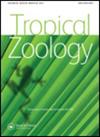多哥(西非)哺乳动物区系组成的生物地理学分析
IF 0.7
4区 生物学
Q4 ZOOLOGY
引用次数: 0
摘要
西非的达荷美峡谷是一个类似于人类的稀树草原的植被区,中间点缀着一片潮湿的森林,其西部(上几内亚森林)和东部(下几内亚森林)都有大片雨林。多哥是一个位于达荷美峡谷中部的小国。本文根据五种不同的生态分布模式对多哥哺乳动物区系的组成进行了生物地理学分析。物种比例最大的是泛非物种(88.0%)。将泛非物种排除在分析之外,哺乳动物区系似乎与上几内亚和下几内亚森林区系相似。只观察到三种特有物种,它们都是啮齿类动物:隐mys zechi(蝙蝠科)、Funisciurus substratus(Sciuridae)和Leimacomys buettneri(Muridae)。仅考虑多物种属,绝大多数物种没有表现出达荷美峡对其自身物种的任何屏障作用,因为所有这些物种都发生在多哥两侧。在8个属中发现了达荷美峡的屏障效应;总体而言,Dahomey Gap对28.6%的多物种属表现出明显的屏障效应。需要强调的是,由于缺乏对整个地区动物群和花群组成的生物地理学审查和荟萃分析,无法充分理解达荷美峡作为生物地理学屏障的作用及其岛屿森林作为特有种中心的作用。本文章由计算机程序翻译,如有差异,请以英文原文为准。
Biogeographic analysis of the composition of the mammalian fauna of Togo (West Africa)
The Dahomey Gap in West Africa is a human-derived savannah-like vegetation zone interspersed by patches of moist forest, with large rainforest blocks at both West (Upper Guinean Forest) and East (Lower Guinean Forest) of its limits. Togo is a tiny country situated in the middle of the Dahomey Gap. In this paper, a biogeographic analysis of the composition of the mammalian fauna of Togo is presented, by classifying each species on the basis of five distinct ecological distribution patterns. The greatest proportion of species were Pan-African (88.0%). Excluding the Pan-African species from the analysis, the mammalian fauna appeared to be affiliated similarly to both Upper Guinean and Lower Guinean Forest blocks. Only three endemic species were observed, all of them being rodents: Cryptomys zechi (Batyergidae), Funisciurus substriatus (Sciuridae), and Leimacomys buettneri (Muridae). Considering only the multispecies genera, the great majority did not show any barrier effect by the Dahomey Gap on their own species, as all of them did occur on both sides of Togo. A barrier effect by the Dahomey Gap was uncovered in 8 genera; overall, the Dahomey Gap apparently showed a barrier effect on 28.6% of the multispecies genera. It is emphasized that the full understanding of the role of the Dahomey Gap as a biogeographic barrier and of its island forests as centers of endemism is impeded by the lack of biogeographic reviews and meta-analyses on the composition of faunal and floral groups of the entire region.
求助全文
通过发布文献求助,成功后即可免费获取论文全文。
去求助
来源期刊

Tropical Zoology
生物-动物学
CiteScore
2.50
自引率
0.00%
发文量
1
审稿时长
>12 weeks
期刊介绍:
Tropical Zoology is an international zoological journal publishing original papers in the field of systematics, biogeography, phylogeny, ecology and conservation of all terrestrial and aquatic animal Phyla from tropical and subtropical areas.
Only papers with new information, high quality and broad interest are considered. Single species description and checklists are not normally accepted. Review papers are welcome. The journal is owned by the Istituto di Ricerca sugli Ecosistemi Terrestri of the Consiglio Nazionale delle Ricerche, Florence, Italy (CNR-IRET) who performs research into the structure and functioning of aquatic and terrestrial ecosystems, focusing in particular on anthropogenic pressure and global change. The knowledge amassed forms the scientific basis for identifying the most appropriate protective and corrective interventions, and provides support for the bodies entrusted with formulating policies for environmental protection and recovery.
 求助内容:
求助内容: 应助结果提醒方式:
应助结果提醒方式:


